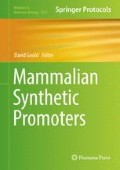Abstract
Recent advances in the development of light-inducible transgene expression systems have overcome many inherent drawbacks of conventional chemically regulated systems. The latest generation of those light-regulated systems that are specifically responsive to different wavelengths allows spatiotemporal control of gene expression in a so far unprecedented manner.
In this chapter, we first describe the available light-inducible gene expression systems compatible with mammalian cells and explain their underlying mechanisms. Afterward, we give a detailed protocol for the implementation of a UVB light-inducible expression system in mammalian cells.
References
Ausländer S, Fussenegger M (2013) From gene switches to mammalian designer cells: present and future prospects. Trends Biotechnol 31(3):155–168. doi:10.1016/j.tibtech.2012.11.006
Weber W, Fussenegger M (2012) Emerging biomedical applications of synthetic biology. Nat Rev Genet 13(1):21–35. doi:10.1038/nrg3094
Hörner M, Weber W (2012) Molecular switches in animal cells. FEBS Lett 586(15):2084–2096. doi:10.1016/j.febslet.2012.02.032
Crefcoeur RP, Yin R, Ulm R, Halazonetis TD (2013) Ultraviolet-B-mediated induction of protein-protein interactions in mammalian cells. Nat Commun 4:1779. doi:10.1038/ncomms2800
Müller K, Engesser R, Schulz S, Steinberg T, Tomakidi P, Weber CC, Ulm R, Timmer J, Zurbriggen MD, Weber W (2013) Multi-chromatic control of mammalian gene expression and signaling. Nucleic Acids Res 41(12):e124. doi:10.1093/nar/gkt340
Müller K, Engesser R, Timmer J, Zurbriggen MD, Weber W (2014) Orthogonal optogenetic triple-gene control in mammalian cell s. ACS Synth Biol 3(11):796–801. doi:10.1021/sb500305v
Nihongaki Y, Yamamoto S, Kawano F, Suzuki H, Sato M (2015) CRISPR-Cas9-based photoactivatable transcription system. Chem Biol 22(2):169–174. doi:10.1016/j.chembiol.2014.12.011
Polstein LR, Gersbach CA (2015) A light-inducible CRISPR-Cas9 system for control of endogenous gene activation. Nat Chem Biol 11(3):198–200. doi:10.1038/nchembio.1753
Konermann S, Brigham MD, Trevino AE, Hsu PD, Heidenreich M, Cong L, Platt RJ, Scott DA, Church GM, Zhang F (2013) Optical control of mammalian endogenous transcription and epigenetic states. Nature 500(7463):472–476. doi:10.1038/nature12466
Yazawa M, Sadaghiani AM, Hsueh B, Dolmetsch RE (2009) Induction of protein-protein interactions in live cells using light. Nat Biotechnol 27(10):941–945. doi:10.1038/nbt.1569
Polstein LR, Gersbach CA (2012) Light-inducible spatiotemporal control of gene activation by customizable zinc finger transcription factors. J Am Chem Soc 134(40):16480–16483. doi:10.1021/ja3065667
Müller K, Zurbriggen MD, Weber W (2014) Control of gene expression using a red- and far-red light-responsive bi-stable toggle switch. Nat Protoc 9(3):622–632. doi:10.1038/nprot.2014.038
Wang X, Chen X, Yang Y (2012) Spatiotemporal control of gene expression by a light-switchable transgene system. Nat Methods 9(3):266–269. doi:10.1038/nmeth.1892
Chen X, Li T, Wang X, Yang Y (2015) A light-switchable bidirectional expression module allowing simultaneous regulation of multiple genes. Biochem Biophys Res Commun 465(4):769–776. doi:10.1016/j.bbrc.2015.08.085
Motta-Mena LB, Reade A, Mallory MJ, Glantz S, Weiner OD, Lynch KW, Gardner KH (2014) An optogenetic gene expression system with rapid activation and deactivation kinetics. Nat Chem Biol 10(3):196–202. doi:10.1038/nchembio.1430
Niopek D, Benzinger D, Roensch J, Draebing T, Wehler P, Eils R, Di Ventura B (2014) Engineering light-inducible nuclear localization signals for precise spatiotemporal control of protein dynamics in living cells. Nat Commun 5:4404. doi:10.1038/ncomms5404
Beyer HM, Juillot S, Herbst K, Samodelov SL, Müller K, Schamel WW, Römer W, Schäfer E, Nagy F, Strähle U, Weber W, Zurbriggen MD (2015) Red light-regulated reversible nuclear localization of proteins in mammalian cel ls and Zebrafish. ACS Synth Biol 4(9):951–958. doi:10.1021/acssynbio.5b00004
Ye H, Daoud-El Baba M, Peng RW, Fussenegger M (2011) A synthetic optogenetic transcription device enhances blood-glucose homeostasis in mice. Science 332(6037):1565–1568. doi:10.1126/science.1203535
Folcher M, Oesterle S, Zwicky K, Thekkottil T, Heymoz J, Hohmann M, Christen M, Daoud El-Baba M, Buchmann P, Fussenegger M (2014) Mind-controlled transgene expression by a wireless-powered optogenetic designer cell implant. Nat Commun 5:5392. doi:10.1038/ncomms6392
Wend S, Wagner HJ, Müller K, Zurbriggen MD, Weber W, Radziwill G (2014) Optogenetic control of protein kinase activity in mammalian cells. ACS Synth Biol 3(5):280–285. doi:10.1021/sb400090s
Schlatter S, Rimann M, Kelm J, Fussenegger M (2002) SAMY, a novel mammalian reporter gene derived from Bacillus stearothermophilus Alpha-amylase. Gene 282(1–2):19–31. doi:10.1074/jbc.273.52.34970
Kain SR, Ganguly S (2001) Overview of genetic reporter systems. Curr Protoc Mol Biol Chapter 9:Unit9.6. doi:10.1002/0471142727.mb0906s36
Li X, Zhao X, Fang Y, Jiang X, Duong T, Fan C, Huang CC, Kain SR (1998) Generation of destabilized green fluorescent protein as a transcription reporter. J Biol Chem 273(52):34970–34975. doi:10.1074/jbc.273.52.34970
Acknowledgment
This work was supported by the Excellence Initiative of the German Federal and State Governments (EXC-294 and GRC-4) and the European Research Council under the European Community’s Seventh Framework Programme (FP7/2007-2013)/ERC Grant Agreement n° 259043-CompBioMat.
Author information
Authors and Affiliations
Corresponding author
Editor information
Editors and Affiliations
Rights and permissions
Copyright information
© 2017 Springer Science+Business Media LLC
About this protocol
Cite this protocol
Hörner, M., Müller, K., Weber, W. (2017). Light-Responsive Promoters. In: Gould, D. (eds) Mammalian Synthetic Promoters. Methods in Molecular Biology, vol 1651. Humana, New York, NY. https://doi.org/10.1007/978-1-4939-7223-4_13
Download citation
DOI: https://doi.org/10.1007/978-1-4939-7223-4_13
Published:
Publisher Name: Humana, New York, NY
Print ISBN: 978-1-4939-7221-0
Online ISBN: 978-1-4939-7223-4
eBook Packages: Springer Protocols

